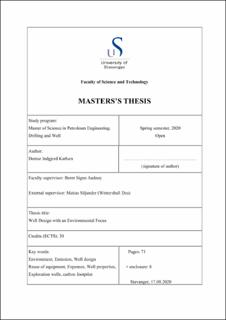| dc.description.abstract | The decisions made during well planning have mainly been focused on safety, cost efficiency and applicability of the design. As the climate have been getting more attention the past years, environment is now high up on the agenda for both the society and authorities. Therefore, the oil industry needs to think of new solutions in order focus more on sustainability and environment.
The Toutatis exploration well was drilled in 2019, close to Lofoten, an environmental sensitive area. It was recognized by a clear environmental profile, which influenced the decision making processes within the whole project. One of the main outcomes from the Toutatis campaign, was that spending more time and workhours in the planning and well design phase can be beneficial. With respect to both the economical side, risk picture and environment. Extra days spent on evaluating operational options, can in some cases be justified by the operational and environmental savings from better suited systems.
The WH and conductor system are known as the ‘weak link’ in the well design. Choosing the CAN- ductor system from Neodrill as a well foundation provided less or no risk of fatigue issues. The construction can be installed and retrieved with light vessel before the rig arrives on location, cutting both rig time, cost, fuel consumption and the environmental impact. The report from Asplan Viak showed that the main environmental, risk and cost benefits came from reduced rig time and casing material. In total, the rig time was four days shorter for the CAN-ductor compared to that of the conventional technology.
A study showed that it also could be favourable to use DP in shallower waters for exploration wells, with an operation time up to 100 days. Based on weather conditions in September and for the drilling rig West Hercules. Beforehand it had been assumed that it would be more cost effective to select the anchor handling system for an exploration well.
Changing even the small details in an operation, can have a major impact. As for example the Dopeless casings from Tenaris, eliminating the need for greasing the casing joints. Hence lowering the total casing costs with up to 10%, and at the same time reduce the human risk and environmental impact. Another briefly mentioned potential is reuse of equipment. The can used for the Toutatis well had previously been run on another well. Followed by inspections and new painting. Resulting in lower use of resources such as workhours, manpower and materials. | en_US |
